
The Riodinini are one of the large tribes of metalmark butterflies. As numerous Riodinidae genera have not yet been unequivocally assigned to a tribe, the genus list is preliminary.
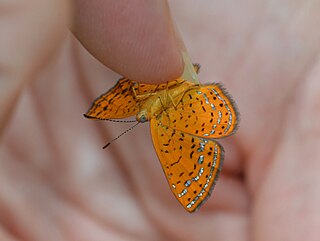
Calephelis muticum, the swamp metalmark, is a butterfly species in the family Riodinidae.
Mojavia is a monotypic moth genus of the family Crambidae erected by Eugene G. Munroe in 1961. It contains only one species, Mojavia achemonalis, which was first described by William Barnes and James Halliday McDunnough in 1914. It is found in North America, where it has been recorded from Arizona, California, Nevada, New Mexico and Texas.

Hemigrotella is a monotypic moth genus of the family Noctuidae. Its only species, Hemigrotella argenteostriata, is found in southern California. Both the genus and species were first described by William Barnes and James Halliday McDunnough in 1918.
Parahypenodes is a monotypic moth genus of the family Erebidae. Its only species, Parahypenodes quadralis, the masked parahypenodes moth, is found in the Canadian province of Quebec. Both the genus and species were first described by William Barnes and James Halliday McDunnough in 1918.

Calephelis nemesis is a butterfly in the family Riodinidae. It is found in the southern part of the United States and Mexico. Its habitats include chaparral canyons near rivers in arid areas, roads, and washes.

Euphilotes rita, the rita blue or desert buckwheat blue, is a species of butterfly of the family Lycaenidae. It is found in Wyoming, Colorado, Arizona, New Mexico and northern Mexico. The species was first described by William Barnes and James Halliday McDunnough in 1916.
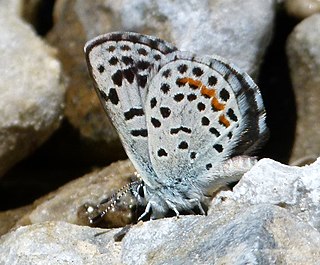
Euphilotes ancilla, the Rocky Mountain dotted blue, is a species of butterfly of the family Lycaenidae. It is found from Washington south to California and southern Alberta and Saskatchewan south through the Rockies and high plains to Wyoming, Colorado, Utah, and northwestern New Mexico. The species was first described by William Barnes and James Halliday McDunnough in 1918.
Lycomorpha splendens is a moth of the family Erebidae. It was described by William Barnes and James Halliday McDunnough in 1912. It is found in North America, including Arizona, California, Nevada, New Mexico, Texas and Utah.
Comadia albistrigata is a moth in the family Cossidae first described by William Barnes and James Halliday McDunnough in 1918. It is found in North America, where it has been recorded from Arizona, New Mexico and Texas.
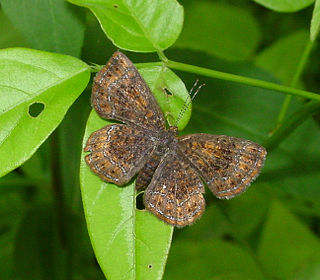
Calephelis borealis, commonly known as the northern metalmark, is a butterfly of the family Riodinidae. It ranges through western Connecticut south through west-central Pennsylvania; central Appalachians and Ohio River Valley. Isolated populations are also found in southwest Missouri and eastern Oklahoma. The habitat consists of open woodland streams near serpentine, shale or limestone barrens.

Callistege triangula is a moth of the family Erebidae first described by William Barnes and James Halliday McDunnough in 1918. It is found in North America, where it has been recorded from Arizona, New Mexico and Texas.

"Calephelis" is a genus of butterflies that belongs to the family Riodinidae. They are resident in the Americas. There are 43 species in the Neotropical regions and 11 species in the Nearctic.
Calephelis rawsoni, commonly known as Rawson's metalmark, is a butterfly of the family Riodinidae. It was described by Wilbur S. McAlpine in 1939 and ranges through southern Arizona, south and west Texas and south to central Mexico. The habitat consists of moist areas including stream edges, gulches, subtropical woodland, shaded limestone outcrops.

Calephelis wrighti, or Wright's metalmark, is a species of metalmark in the butterfly family Riodinidae. It is found in North America.
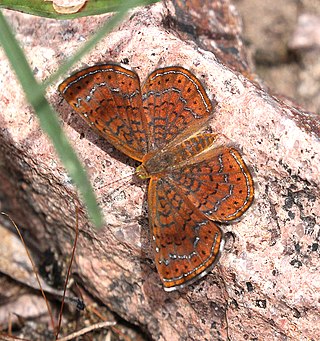
Calephelis arizonensis, the Arizona metalmark, is a species of metalmark in the butterfly family Riodinidae. It is found in North America.
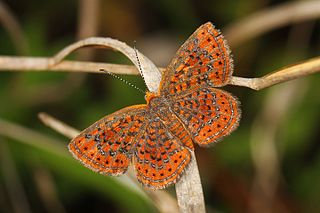
Calephelis virginiensis, the little metalmark, is a species of metalmark in the butterfly family Riodinidae. It is found in North America.

Apodemia mejicanus, the Mexican metalmark or Sonoran metalmark, is a species of butterfly in the family Riodinidae. It was first described by Hans Hermann Behr in 1865. It is found in North America.














